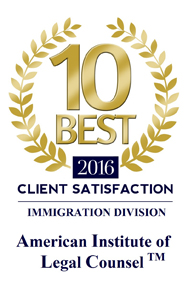The EB-5 Program stands for the “Fifth Employment-Based Immigrant Visa” category. Many immigrants who have the funds, but no other way to obtain a green card look at the EB-5 Program because it is the “million dollar green card.” Let’s break this down.
What is the Required Investment?
The amount of the investment is either 1 million USD or 500,000 USD in a targeted employment area (TEA). TEAs are areas that at the time of the investment have unemployment rates of at least 150% of the national average. TEAs also include rural areas, which are any areas located outside a metropolitan statistical area (as designated by the Office of Management and Budget) or outside the boundary of any city or town having a population of 2,000 or more according to the decennial census.
Is the EB-5 Green Card Subject to a Quota?
Yes, the EB-5 green card is subject to a quota system. Each year, 10,000 EB-5 visas are available. Of these 10,000 visas, 3,000 are reserved for investors who invest in a targeted employment area (TEA) and another 3,000 visas are reserved for investors who invest in EB-5 Regional Centers.
As of January, 2017, the priority dates are current for citizens of every country except Mainland China. As of January 1, 2017, for citizens of Mainland China, those who have a priority date of April 8, 2014 or earlier are eligible to file their green cards. As of January 1, 2017, citizens of Mainland China must wait about three years before they are eligible to file their green card applications. Citizens of all other countries can file their green card applications at the same time of filing the immigrant visa petition (Form I-526). There is a backlog for citizens of Mainland China since they file the most EB-5 visa petitions. Foreign entrepreneurs from other countries include South Korea, Taiwan, Vietnam, Iran, Russia, India, Mexico, Nigeria, Japan, Venezuela, Great Britain/Northern Ireland, Egypt, Canada, Hong Kong, South Africa, Brazil, Germany, Bangladesh, and Malaysia.
Once the green card is approved, it will be a two-year conditional card, that requires the foreign investor to file a petition to remove conditions. If approved, a permanent 10-year green card would be issued. The lawful permanent resident could apply for naturalization after 5 years. (If denied, the foreign investor would be placed into removal proceedings).
What are the Types of Investment?
The investment must be cash, equipment, inventory, other tangible property, cash equivalents and indebtedness secured by assets owned by the alien entrepreneur (provided that the alien entrepreneur is personally and primarily liable and that the assets of the new commercial enterprise upon which the petition is based are not used to secure any of the indebtedness). All capital is valued at fair-market value in United States Dollars. Assets acquired, directly or indirectly, by unlawful means (such as criminal activities) shall not be considered capital for the purposes of section 203(b)(5) of the Act.
Under the Basic Program, EB-5 investors may pool their funds into a new commercial enterprise. Under the RC, an investment fund can be created for the purpose of investing in EB-5 compliant projects.
What is the Difference Between the Basic Program and a Regional Center?
There are other differences apart from the visas set aside for the Regional Center.
Under the EB-5 “Basic Program,” investors must invest in a “new” commercial enterprise that creates or saves ten U.S. jobs and engages in the management of the enterprise. To be considered a “commercial” enterprise, the business must be a for-profit company that has ongoing, lawful business transactions. The business can be structured as a sole proprietorship, a partnership (limited or general), a holding company, a joint venture, a corporation, or a business trust or other entity (publicly or privately owned). A holding company includes its wholly owned subsidiaries (as long as each subsidiary has ongoing for-profit lawful transactions).
For the Basic Program, “New” commercial enterprises are either 1) businesses formed after November 29, 1990; or 2) businesses established on or before November 29, 1990 that is either a) purchased and the existing business is restructured or reorganized in such a way that a new commercial enterprise results or b) expanded through the investment so that a 40-percent increase in the net worth or number of employees occurs. It is the individual investor’s legal burden to prove “job creation” through his/her investment.
Under the Basic Program, only “direct” job creation meets the 10-job per investor requirement during the first two years following the initial approval. “Direct” jobs are actual identifiable jobs for qualified employees located within the commercial enterprise into which the EB-5 investor has directly invested his or her capital. Full-time employment requires that each employee work for a minimum of 35 hours weekly. U.S. workers include: U.S. citizens, U.S. permanent residents, and asylees/refugees. They DO NOT include those on H-1B, L-1, O-1, and E. Independent contractors and other non-U.S. workers may be hired by the enterprise, but are not counted toward satisfaction of the job creation requirement/
With the “Regional Center Program,” a foreign investor can invest capital in U.S. entities. A Regional Center is a business entity, organization, or agency that has been approved by USCIS that focuses on a specific geographic area within the United States to promote economic growth, regional productivity, job creation and increased domestic capital investment. As of December 6, 2016, USCIS has approved 865 regional centers. As of January 9, 2017, USCIS terminated several regional centers. It is the Regional Center’s legal burden to prove that for every investor, the Regional Center will create 10 U.S. jobs.
In the Regional Center Program, direct and indirect jobs may be used to meet the 10-job per investor requirement. “Indirect” jobs are those jobs shown to have been created collaterally or as a result of capital invested in a commercial enterprise affiliated with a regional center by an EB-5 investor. Indirect employment includes jobs created at nearby businesses and need not be directly related to the EB-5 Project. It may include equipment manufacturers and services used by the EB-5 enterprise, as well as construction jobs. For example, a ski lodge Regional Center may also show job creation at nearby restaurants and ski ships which will experience increased volume in customs due to the creation of the ski lodge.
What Are the Benefits of Investing in a Regional Center (RC)?
RCs offer attractive benefits to project developers and to investors. The single most important benefit is that the investor does not need to direly manage or run the investment enterprise! This is ideal for many clients who do not have the experience, interest, time or skills to directly manage or run the investment enterprise or may wish to pursue employment unrelated to the investment.
Second, RCs are not limited to sponsoring a single project, or even a single type of project. TCs are allowed to develop and manage multiple projects and also to sponsor third party projects. By choosing this option, you save 18 months or more which is the time to receive a Regional Center approval not counting the effort of applying for RC designation.
Third, the RC option eliminates many of the problems which investors must overcome in the Basic Program. First, investing in an RC allows foreign nationals to invest in an RC project without meeting the job creation requirement as an individual investor. Remember that the RCs have already been screened by USCIS for the job-creation requirement, the “new commercial enterprise” burden, and whether the entity is located in a TEA.
Fourth, it allows for alternatives for existing visa options. For instance, a CEO who is ineligible for an L-1 or EB-1C visa, could begin working for any individual or entity in the U.S. after he or she receives work authorization as an EB-5 RC investor. Fifth, investors may live and work wherever they want, regardless of the EB-5 RC Program.
Finally, RC investors may get their green cards faster. EB-5 investments must be “at risk” with no guarantee of the return of any capital. When the RC investor deposits funds into the Regional Center, or places it in an escrow account, the funds are considered “at risk.” Unlike the Basic Program which requires that the commercial enterprise spend a substantial portion f the invested EB-5 funds to prove that the funds are “at risk”, the RC meets this requirement as soon as the investment is made, which results in shorter wait times before the immigrant investor may submit their application.
Who Can Apply for Regional Center Designation?
Nearly any business entity can apply for RC designation, including state or local government agencies, a partnership or any other U.S. commercial entity. Examples of RC projects include mixed-use shopping centers, real estate programs converting low-yielding properties into high-yielding mixed-use commercial properties, ski resorts, urban redevelopment projects, film and television studio expansion, public transportation projects, business redevelopment projects among others.
Takeaway Message:
DO NOT eliminate the EB-5 visa because you do not have the skills to manage an EB-5 project. If you have the capital, then you have a choice to choose investing in either a USCIS-approved Regional Center or invest under the Basic Program. If you do not have the capital, then you may “pool” the funds under the Basic Program.
We offer a free case evaluation by phone. We are available Monday through Friday from 8:30 am to 8:00 pm and Saturday from 8:00 am to 12:00 pm. In-person consultations are by appointment only. Please call our office at 301.529.1912 or click here to contact us. Please be sure to provide a timeline of events along with details of your entire immigration history.









